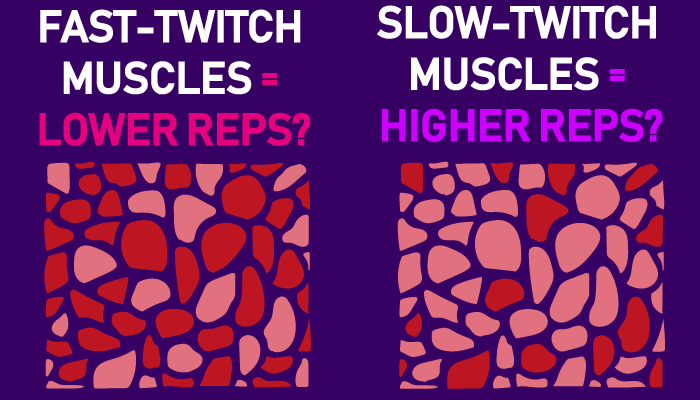
When it comes to maximizing muscle hypertrophy, there are many different ideas put forth. One of these ideas is that you should be training muscles based on their predominant fiber-type.
The Logic Behind Fiber Type Training
Muscles are generally made up of slow-twitch and fast-twitch muscle fibers.
Training muscles based on their fiber type would suggest you train muscles that are predominantly slow-twitch with higher rep ranges (lighter loads) and muscles that are predominantly fast-twitch with lower rep ranges (heavier loads).
Slow-twitch muscles produce low amounts of power but take a while to fatigue. Therefore, it’s not unreasonable to think these fibers would be best stimulated with lighter loads and higher rep ranges.
On the other hand, fast-twitch muscles produce higher amounts of power but fatigue relatively quickly. Therefore, it’s not unreasonable to think these fibers would be best stimulated with heavier loads and lower rep ranges.
But, do these ideas work?
Let’s find out what the research says.
Training Based on Fiber Type: The Research
This recent paper by Schoenfeld et al. aimed to find out just this, whether training muscles based on their predominant fiber type resulted in greater muscle growth.
Protocol:
The muscles this paper investigated was the medial gastrocnemius, lateral gastrocnemius, and soleus (which collectively are the calf muscles).
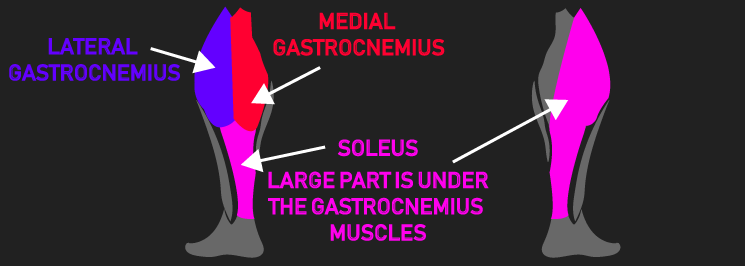
The medial and lateral gastrocnemius are believed to be a fairly even split of both slow-twitch and fast-twitch muscle fibers, while the soleus is believed to be almost entirely slow-twitch.
26 untrained men had one of their legs assigned to a light load condition while their other leg was assigned to a heavy load condition.
With the leg assigned to the light load condition, subjects trained both the unilateral seated calf raise and unilateral standing calf raise for 4 sets of 25 reps (each set taken to failure), twice per week for 10 weeks.
With the leg assigned to the heavy load condition, subjects trained both the unilateral seated calf raise and unilateral standing calf raise for 4 sets of 8 reps (each set taken to failure), twice per week for 10 weeks.
Measurements:
Thickness of the medial gastrocnemius, lateral gastrocnemius, and soleus was measured before and after the training period for both legs via ultrasound imaging.
Results:
What the researchers found was that neither the medial gastrocenemius, lateral gastrocnemuis, or soleus favored the use of heavy or light loads. In other words, all three muscles responded similarly to the use of heavy and light loads.

If training muscles based on their fiber type did truly maximize hypertrophy, we would expect the soleus, in particular, to respond better to the use of light loads. As remember, the soleus is predominantly slow-twitch. But this was not the case.
Therefore this study suggests that training muscles based on their fiber type does not enhance hypertrophy.
Now, this is the only study to data that has aimed to find out if training a muscle based on their fiber type is beneficial. Drawing conclusions from a single paper is limited, and hopefully future research can add to this topic.
But regardless, there doesn’t seem to be a practical appeal to training muscles based on their fiber type.
Before moving on, if you’re curious about creating an effective training program for muscle hypertrophy, our high quality partner Alpha Progression can help. It can generate a highly effective program for you, track your workouts live with in-built progression recommendations, provide graphs displaying your long term progress, and it has a massive exercise database with more than 550 exercises.
Click HERE (the link opens in a new tab) to get a free 2 week trial of the apps features. If you like it and go beyond, the link also gives you 20% off a subscription!
We never promote trash at the House of Hypertrophy, so rest assured the app is high quality. The reviews speak to this, 4.8 starts (based on more than 7,000 reviews) on Google play, and 4.9 stars in Apple’s store (based on nearly 400 ratings).
Practical Considerations
Based on numerous studies, the vast majority of the lower body appears to be a fairly even split of fast-twitch and slow-twitch muscle fibers. The exception here is the soleus, which of course was the muscle investigated in the already mentioned Schoenfeld et al. study.
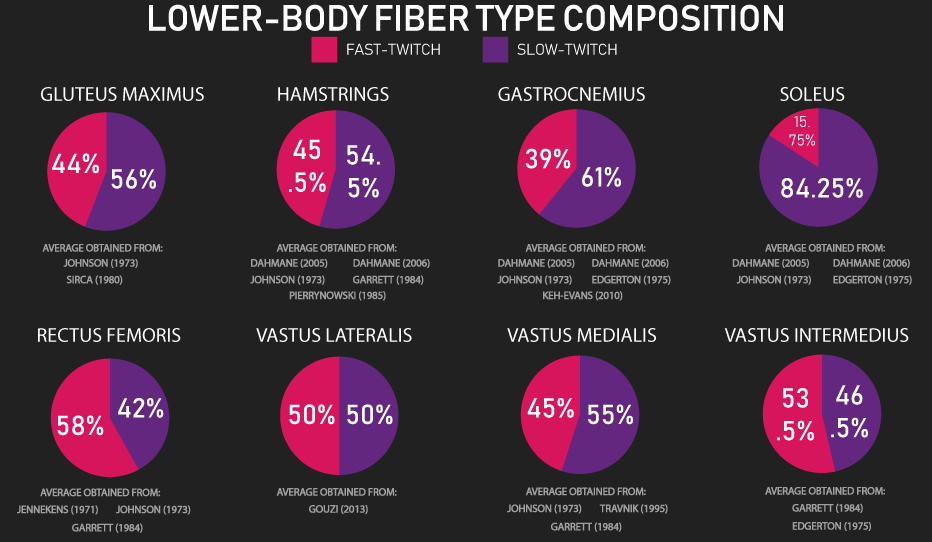
The same applies to the upper body, numerous studies suggest that the muscles of the upper body are fairly split between fast-twitch and slow-twitch muscle fibers.
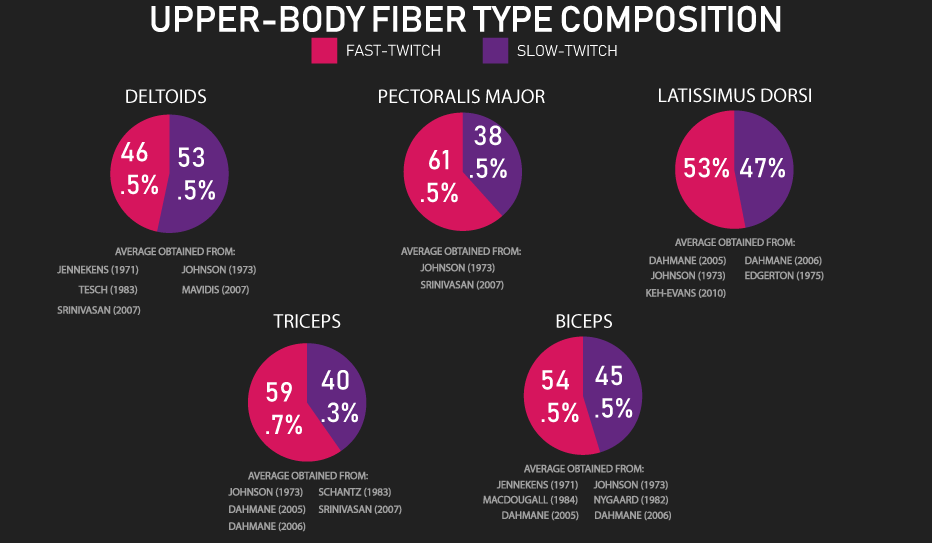
What this means is that you can’t practically train muscles based on their fiber type, because most muscles appear to be fairly split between fast-twitch and slow-twitch muscle fibers.
The values from these studies are averages, there would, without doubt, be individuals who diverge from this and have muscles that are predominantly fast or slow-twitch.
However, ignoring invasive methods, there really isn’t a practical or reliable way to know which of your muscles may be predominantly fast or slow-twitch.
There have been suggestions that someone can determine their fiber-type breakdown though knowing the number of reps they can perform with a submaximal load.
For instance, one suggestion is that if you perform more than 9 reps with 80% of your one-rep max on a particular exercise, the muscle(s) in that exercise are predominantly slow-twitch. But if you perform 9 or fewer reps, the muscle(s) are predominantly fast-twitch.
A study by Douris et al. did indeed find a statistically significant relationship between the number of reps performed on a 70% one-rep max leg press and the percentage of fast-twitch muscle fibers in the quadriceps.
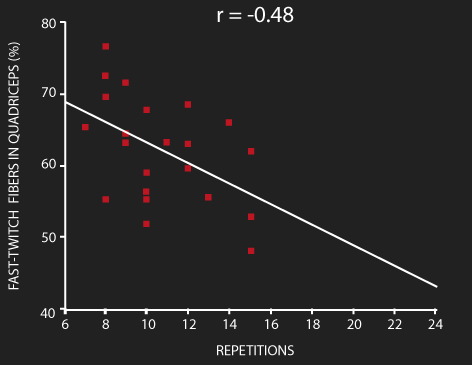
Looking at the data, the relationship is negative, meaning that the more reps a person could perform with 70% one-rep max on the leg press, the fewer percentage of fast-twitch muscles they had in their quadriceps (as you’d expect).
That said, the relationship wasn’t particularly strong, it’s Pearson correlation coefficient was -0.48.
0 would indicate no relationship whatsoever, while -1 would indicate a very strong relationship (1 would indicate a strong positive relationship).
-0.48 is nearly right in the middle of this.
An important limitation of this study was an indirect method was used to determine fiber-type proportions, which is questionable validity wise.
A study by Terzis et al. did directly assess fiber-type proportions through muscle biopsies.
They measured the relationship between reps achieved on a 70% and 85% one-rep max leg press and slow-twitch fiber percentage in the vastus lateralis (part of the quadriceps).

The Pearson correlation coefficient for both was less than 0.2, essentially meaning there was virtually no relationship between reps achieved with the leg press and fiber-type proportion.
Therefore, using the number of reps you can perform with a submaximal load as an indication for whether a muscle is more slow or fast-twitch is likely quite unreliable.
Conclusion
To wrap up, based on the current evidence and practical considerations, there does not seem to be much of an appeal to training muscles based on their fiber type.
As an additional note, we have a bunch of articles exploring the optimal rep ranges to build muscle.
Remember to feel free to check out the Alpha Progression App if you’re interested. Also feel free to check out our free bench press e-book below.

